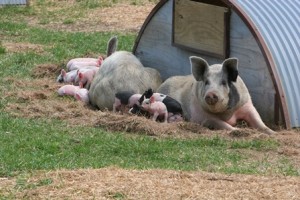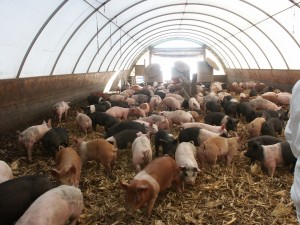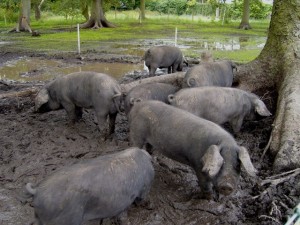Pig Housing

We promote systems that enable pigs to express their natural behaviors as well as allowing integration within a wider farming system. This means a fundamentally different approach to the widespread use of confined housing systems, with all the negative welfare connotations, to one based on maximizing opportunities for outdoor exploration. The most common form of housing found in outdoor breeding systems are mobile arcs and huts, which provide basic shade and shelter, although other more semi-permanent structures, such as straw-bedded hoop barns are also popular for rearing and fattening.
Enriched Housing
An understanding of behavior allows the design of housing that meets basic behavioral needs. By observing family groups of pigs in their natural environment, Stolba and Wood-Gush (1984)identified key features of enriched pens that would enable pigs to perform key natural behaviors. These included locating of nesting, activity and rooting areas as well as a corridor connecting pens. Creating housing units with family groups of four familiar sows, their fattening offspring, a boar and replacements provided an environment that enabled normal social behaviors, as well as social contact that enhanced the synchronization of heat and lactational estrus.
Nest sites, which in a natural environment would be within bushes, can be created by pen walls and permeable farrowing rails. Based on observations of pigs in natural habitats, there are key provisions for nesting sites that promote natural nesting behaviors (Stolba and Wood-Gush, 1984):
- Nests should be sheltered against wind and possibly rain, and provide cover on two sides
- There should be an open view from the nest site so approaching persons and/or predators can be clearly seen approaching
- Open fronted buildings are best orientated to open southward
- There should be a marked change of area between the part of the pen for nesting and the parts used for other activities
- The potential nest sites should not coincide directly with the area used for feeding the pigs
- Nests sites should be at least 2-3m in diameter.
Other pen enrichment features identified by Stolba and Wood-Gush (1984) that will help to promote natural behavior, include:
- Provision of a defecating corridor at least 5 m away from the nesting area that mimics the areas between bushes that pigs would use in a natural environment
- A main feeding area positioned away from the nest area
- A rack for gathering straw for nest building
- Peat or bark and a levering bar in the rooting area as suitable materials for wallowing and digging
- A post for comfort and marking behaviour in the central activity area
- A part roofed and part open area that mimics a forest border habitat
- The pen size should allow the pigs to walk about 5 m away from the nest to defecate.
Fattening Pigs in Straw-Bedded Yards
Providing straw-bedded yards for fattening pigs is an alternative to the more conventional slatted floor systems as it at least enables the exhibition of some natural behaviors, including rooting activity, chewing and positive group interaction, as well as reducing pig and pen-directed negative behavior such as biting (Fraser et al., 1991; Kelly et al., 2000; Guy et al., 2002).
Hoop Barns
 Hoop barn pig housing used widely in the US are low cost, large, simple, tentlike shelters normally consisting of steel pipe arches or trusses covered with an ultraviolet-resistant polyvinyl fabric (Honeyman, 2005). In winter months they can be either partly or completely enclosed using straw bales as end-walls, and conversely in summer can be open-ended. They are normally earth floored with bedding. Where necessary, temporary stalls may be fitted. In the US they are used mainly for finishing pigs but they can be used for all age groups, including rearing weaned pigs. They are seen as having positive impacts on behavior compared with other confined systems (Lay et al., 2000).
Hoop barn pig housing used widely in the US are low cost, large, simple, tentlike shelters normally consisting of steel pipe arches or trusses covered with an ultraviolet-resistant polyvinyl fabric (Honeyman, 2005). In winter months they can be either partly or completely enclosed using straw bales as end-walls, and conversely in summer can be open-ended. They are normally earth floored with bedding. Where necessary, temporary stalls may be fitted. In the US they are used mainly for finishing pigs but they can be used for all age groups, including rearing weaned pigs. They are seen as having positive impacts on behavior compared with other confined systems (Lay et al., 2000).
Other innovative and alternative models of housing for outdoor pigs have been tested e.g. a Yurt-like stucture ((Lammers and Harmon, 2015) and a 12-sided tent (in Hermansen et al., 1999).
Reducing Piglet Mortality
Visit the section on Piglet Rearing for information on housing and piglet mortality.
Heat Stress
A pig’s body temperature should remain within limits that allow normal functioning and activity. At temperatures beyond this, heat stress can occur. The first sign is panting and, if the body temperature continues to increase, the animal will collapse, become comatose and will finally die if no action is taken (Defra, 1993).
When pigs are continuously housed in artificial environments, there is always a risk that malfunctioning or incorrect adjustment of ventilation systems will result in heat stress. Pigs kept outdoors are unlikely to suffer such conditions. However, they are particularly vulnerable to radiant heat gain during periods of hot, sunny weather as loss of body heat via convection and conduction is minimal. It is critical during these times that the pigs are provided not only with shade but also with wallowing areas so that evaporative heat loss can occur.
Good Practice for Arcs and Huts:
- All arcs and huts used should be liberally provided with bedding and have a warm, draught-free lying area. This is especially important for the sow and litter at farrowing, during the suckling period and for newly weaned pigs.
- Arcs and huts should be properly maintained, especially to ensure that damage through handling or by the pigs does not produce sharp edges that may injure the animals.
- Adequate shelter must be provided to protect the animals from extreme weather conditions. Arcs should be well fixed to the ground, particularly in cold windy conditions and should be sited so that the doorways can be adjusted to allow for changing weather circumstances. Wet conditions create greater welfare problems than the cold, as moisture is easily carried into the arcs on feet and bodies, causing chilling in piglets, and provides the ideal environment for micro-organisms to flourish.
- Adequate shelter must also be provided to protect the animals from the sun in summer. Wallows should be provided for breeding stock to allow them to cool themselves and to produce mud that can help prevent sunburn.


 British English
British English


Comments are closed.